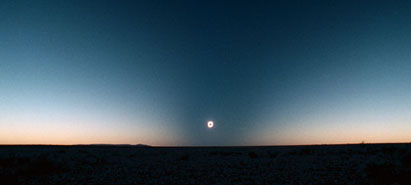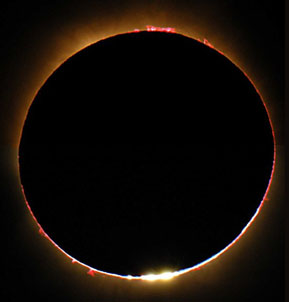If you're considering joining Sky & Telescope and Spears Travel to see November 3rd's total eclipse of the Sun, here are three numbers I'd like you to consider:
29, 12, and 1.002.

The eclipsed Sun was just 4° above the southwestern horizon when Alson Wong captured this wide-angle view in December 2002. The Moon's narrow shadow created a dramatic interplay of light and dark in the sky.
This eclipse only makes landfall across central Africa, where the path is only 29 miles across (47 km) at its widest. There are no big cities along the track, much of which is likely to be under the heavy cloud cover typical of tropical climates. It's what eclipse meteorologist Jay Anderson calls "an imposing meteorological challenge." And yet our viewing site at Lake Turkana in Kenya has good prospects for clear skies — about the best anywhere on the continent. So views of totality will be a rare treat in November, an event likely to be seen by very few people.
The Sun's altitude during totality at Lake Turkana, just 12° high, will allow us to see and photograph the shoreline's dramatic foreground and the distant hills on the other side during totality. Even better, the approach and departure of the umbral shadow will be amazing. As anyone who saw 2002's total eclipse from Australia vividly remembers, the eclipsed Sun becomes surrounded by a dark circle of sky that gives way to colorful twilight on either side, as this amazing photo by Alson Wong shows.

Imagine seeing the solar chromosphere and prominences all around the Sun's disk during totality. That's what Derek Hatch captured at third contact in December 2002. The eclipse in November 2013, as seen from Kenya, offers very similar geometry.
Derek Hatch
And November's eclipse has a magnitude of only 1.002. This means that at mid-eclipse the Moon's disk is just 0.2% wider than the Sun's. While this geometry dictates that totality will be brief, a bit more than 11 seconds, it promises to show you the Sun as you've never seen it — with towering crimson-red prominences leaping from the brilliant chromosphere around virtually the entire circumference of the eclipsed solar disk. This view from the 2002 eclipse by Derek Hatch dramatically shows what awaits us — and, just as it was then, the Sun is going to be near the maximum of its activity cycle.
Actually, there's a fourth number to consider: 1° south. That's the latitude of Nairobi, Kenya's capital and the staging point for our journey together. Nights at the Sweetwaters Tented Camp and the Samburu Intrepids Club will offer spectacular (Moon-free!) views of the magnificent southern sky. Alpha and Beta Centauri will linger over the horizon at sunset, and later on you can use your binoculars or telescope — or just your eyes alone — to take in the magnificent Magellanic Clouds.
I can't wait to see all these celestial marvels, and I'll hope you'll be with me to enjoy them too!
Kelly Beatty is a tour leader for Sky & Telescope's Kenya Adventure.
 0
0
Comments
You must be logged in to post a comment.